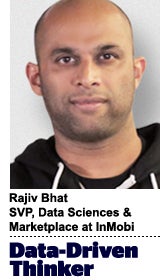 “Data-Driven Thinking” is written by members of the media community and contains fresh ideas on the digital revolution in media.
“Data-Driven Thinking” is written by members of the media community and contains fresh ideas on the digital revolution in media.
Today’s column is written by Rajiv Bhat, senior vice president of data sciences and marketplace at InMobi.
When putting together a content strategy, marketers face a big question: What comes first: the data or the creative?
I’d wager that most would say that marketers should use data as the basis of campaigns and build creative based on acquired and analyzed data.
I regularly make that argument, but we are in a digital content revolution, with brands experimenting and reaching consumers through new creative media, such as 360-degree photos and videos, virtual reality, vertical videos and live-streaming videos.
Data-rich optimization works for finding local maxima in returns. For example, one knows a particular kind of creative works well but would want to test it in different colors. When Marissa Meyer worked at Google, she famously tested 40 shades of blue at 2.5% of traffic each to find the best shade to use for search result links.
However, this is often not enough, and one might need to break out to a new global maximum. Typically, this happens by some hitherto new form of creative. This is one place where intuition beats data.
New Creative Formats Drive Growth
Ordinarily, I would argue that analyzing consumer behaviors should lay the foundation for an advertising campaign. However, when experimenting with new forms of creative, such as augmented reality, marketers face the dilemma of having very little data on hand. Should that stop them from innovating?
By starting with creating content concepts first, creative teams have the freedom to develop their work free of restrictions. In the past year, content creation was the No. 1 factor contributing to the success of B2B marketers, and 85% saw improvement when they developed higher-quality, more efficient content. Developing content not tied to a specific delivery method leaves the opportunity for more engaging content and the chance to explore new creative formats, which is much more likely to be shared.
Right now, mobile video is one of the most popular ad formats, and in 2015 Mary Meeker predicted that video content would represent 74% of all internet traffic by the end of this year. This means digital marketers should consider capitalizing on the power of compelling video content for higher engagement, as opposed to conversions. By emphasizing the content first, instead of relying only on data, the human element of the creative process remains, and you also save time on the back end of your content development.
Don’t Forget The Data
By borrowing techniques from data science, statistics and artificial intelligence to analyze structured and unstructured data, marketers can uncover patterns and relationships to make predictions about future outcomes and events. It’s important to experiment. By testing simple video, static and text ads, you can determine which engagement metrics to use for each format. Often these engagement metrics can differ by orders of magnitude, and each will further depend on the particular campaign. This means that choosing the right option doesn’t necessarily mean choosing the expensive option. Once these metrics have been determined, it’s worth investing in building out something bold and creative within that space.
But, does relying too much on data and statistics take the human element away from the creative process and lead to the same content over and over?
Becoming data-driven helps companies make informed decisions for everything from creating the overall strategy for a campaign to identifying and targeting its audience. The creative process also becomes less time intensive by leveraging data to expedite the development process and personalize the consumer experience.
Cannes Lions recently introduced the Creative Data Lion to recognize creative campaigns that use data as a catalyst for creativity and demonstrate how the use of data enhanced the consumer experience. This award was created to recognize campaigns that are using data in different ways from enhancing campaigns, targeting, visualization tactics and use of real-time data, among others.
So Which Do You Choose First: Data Or Content?
Driving a strategy with data allows companies to take advantage of real-time engagement opportunities and capitalize on breaking trends. Creatives can have different half-lives; understanding the longevity of creatives and making that part of the creative strategy is key. Ultimately, the marketer must determine which method works best based on the creative media and available data. Looking at both the creative options and data enhances content strategies.
A good data-led creative strategy has four components to it: a robust way to rank creatives based on various engagement metrics, recent performance and cost; criteria to cull lagging creatives from the mix; a rebalancing of spend to favor high-performing creatives; and the budget for testing new incremental and discontinuously different creative.
By making informed decisions ahead of campaign strategies, marketers can develop content that works toward the ultimate goal of squeezing as much ROI from these campaigns as possible.
Follow InMobi (@InMobi) and AdExchanger (@adexchanger) on Twitter.












